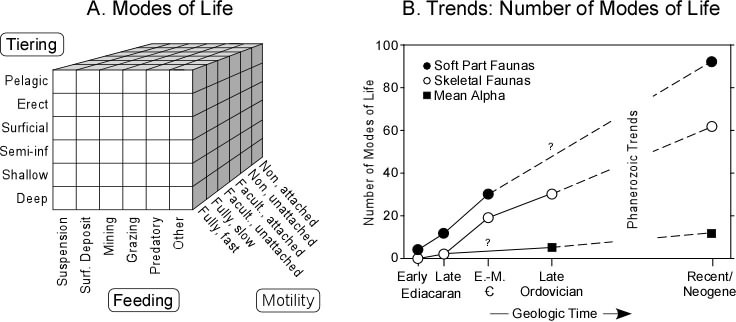Difference between revisions of "Andrew Bush's Research Page"
(→Changes in ecospace use though the history of animal life) |
(→Changes in ecospace use though the history of animal life) |
||
| Line 3: | Line 3: | ||
Richard Bambach and I have been using an "ecospace cube" based on vertical tiering, motility level, and feeding mechanism to classify marine animals into ecologic categories. With this framework, we have been taking several approaches to comparing ecosystems through geologic time. With Doug Erwin, we have tracked the number of ecological modes of life utilized by the total marine animal fauna from the Ediacaran to the Recent, and with Gwen Daley we have traced changes in the relative abundance of these modes of life in local communities. In an ongoing project, we are relating these changes in ecospace occupation to changes in alpha (within-habitat) diversity through the Phanerozoic. | Richard Bambach and I have been using an "ecospace cube" based on vertical tiering, motility level, and feeding mechanism to classify marine animals into ecologic categories. With this framework, we have been taking several approaches to comparing ecosystems through geologic time. With Doug Erwin, we have tracked the number of ecological modes of life utilized by the total marine animal fauna from the Ediacaran to the Recent, and with Gwen Daley we have traced changes in the relative abundance of these modes of life in local communities. In an ongoing project, we are relating these changes in ecospace occupation to changes in alpha (within-habitat) diversity through the Phanerozoic. | ||
| − | |||
| − | [[Image:TrendsRelAbund.jpg]] | + | [[Image:Ecocube&Trends.jpg|frame]] |
| + | |||
| + | |||
| + | [[Image:TrendsRelAbund.jpg|frame]] | ||
== Recognizing & reconstructing patchy faunal gradients from the fossil record == | == Recognizing & reconstructing patchy faunal gradients from the fossil record == | ||
Revision as of 03:26, 10 February 2007
Changes in ecospace use though the history of animal life
Richard Bambach and I have been using an "ecospace cube" based on vertical tiering, motility level, and feeding mechanism to classify marine animals into ecologic categories. With this framework, we have been taking several approaches to comparing ecosystems through geologic time. With Doug Erwin, we have tracked the number of ecological modes of life utilized by the total marine animal fauna from the Ediacaran to the Recent, and with Gwen Daley we have traced changes in the relative abundance of these modes of life in local communities. In an ongoing project, we are relating these changes in ecospace occupation to changes in alpha (within-habitat) diversity through the Phanerozoic.
Recognizing & reconstructing patchy faunal gradients from the fossil record
Using an ecologic ordination technique called FSPA, I can detect the presence of patchiness along onshore-offshore faunal gradients in the fossil record. The example below shows an ecologic ordination produced by FSPA of fossil data collected from the Upper Devonian of Virginia by Rod Brame. Each branch of this ordination is a sub-gradient along the major onshore-offshore gradient in water depth and energy that existed in the Devonian sea. Further analyses of these data indicate that patchiness existed in both onshore and offshore habitats. Work with Gwen Daley on the Pliocene of Virginia indicates that patchiness was present there, as well. This method should give us a better understanding of the environmental factors that control the distrubutions of fossil taxa and, in some cases, could indicate the presence of environmental variations undetected by traditional sedimentological methods.
[INSERT PIC—FrasFSPA.jpg]
Stratigraphy, paleontology, & extinction in the Upper Devonian of New York
I have been documenting the stratigraphy and paleontology across the Frasnian/Famennian boundary in New York state and into northern Pennsylvania. The immediate goals include constraining the position of the boundary and tabulating species abundances in the strata spanning the interval. The paleontological data will ultimately be subjected to statistical methods like confidence intervals on stratigraphic ranges and FSPA to determine the rapidity of the extinction and its effects on onshore-offshore gradients in species composition.
[INSERT PIC—TGA.jpg]

